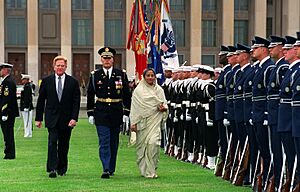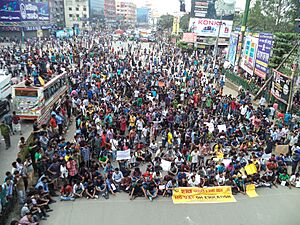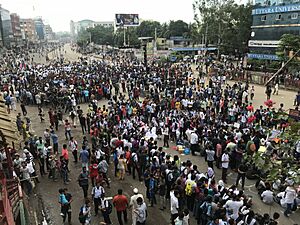History of Bangladesh (1971–present) facts for kids
The history of Bangladesh since 1971 tells the story of the country after it became independent from Pakistan. It's a journey of building a new nation, facing challenges, and growing over the years.
Contents
Bangladesh's Early Years (1972–1980)
Sheikh Mujibur Rahman Takes Charge

After Bangladesh became independent, its founding leader, Sheikh Mujibur Rahman, was released from prison. He quickly became the country's first prime minister in 1972. The politicians who were elected in 1970 formed the new country's first parliament.
The new government faced huge challenges. Millions of people had been forced to leave their homes during the war. The country needed food, medicine, and other basic supplies. A big cyclone in 1970 had already caused damage, and the war made the economy much worse.
Sheikh Mujibur Rahman worked to get Bangladesh recognized by other countries. He helped Bangladesh join the United Nations and the Non-Aligned Movement. He traveled to the United States and Europe to get help for the country. He also signed a friendship treaty with India, which promised economic help and training for Bangladesh's security forces.
The government worked hard to help the 10 million refugees return home. The economy slowly started to get better, and a major famine was avoided for a while. In 1972, a new constitution was created, and elections were held. Mujib and his party won with a large majority. He planned programs to improve education, sanitation, healthcare, and electricity across the country.
However, from March to December 1974, a terrible famine hit Bangladesh. Many people died from hunger during this time.
Left-Wing Uprising
While Sheikh Mujibur Rahman was in power, some groups wanted to create a different kind of government. A left-wing group called the Gonobahini fought against the government. They wanted Bangladesh to become a Marxist country.
The government responded by forming a special force called the Jatiya Rakkhi Bahini. This force was given special powers and was accused of human rights abuses against people, including political killings.
One-Party Rule (BAKSAL)
In January 1975, Sheikh Mujibur Rahman declared a state of emergency. His supporters in parliament approved a change to the constitution that banned all other political parties. Mujib became president and was given special powers. His political supporters formed the only legal party, called BAKSAL. This party focused on helping farmers and workers and took control of the government.
Sheikh Mujibur Rahman's Assassination
On 15 August 1975, a group of army officers attacked the president's home. They killed Mujib, his family, and his staff. Only his daughters, Sheikh Hasina Wajed and Sheikh Rehana, who were visiting West Germany, survived. They were not allowed to return to Bangladesh for a long time.
After Mujib's death, Bangladesh faced many years of political trouble. The officers who carried out the first coup were soon overthrown by other groups. There were several more coups and political killings. Order was mostly restored in 1977 when army chief Ziaur Rahman took control. He became president in 1978 and signed a law that protected the people involved in Mujib's assassination from being punished.
Ziaur Rahman's Military-Civilian Rule (1975–1981)
After several military takeovers, General Ziaur Rahman became a powerful leader. He promised the army's support to the civilian government. He dissolved parliament and declared martial law, which meant the military was in charge.
Zia worked to improve the government and economy. He started new development programs and focused on family planning. In 1976, he became the main martial law administrator and then president in 1977. He promised new elections.
As president, Zia announced a plan for economic reform. He slowly ended martial law. In June 1978, he won a five-year term as president with 76% of the votes. In 1979, parliamentary elections were held, and more than 30 parties took part. This marked a shift back to a more democratic government. The Awami League (AL) and the Bangladesh Nationalist Party (BNP), which Zia founded, became the two main parties.
In May 1981, Zia was assassinated in Chittagong by some military members. The attempted coup did not spread. The vice-president, Abdul Sattar, became acting president. He called for new elections, which he won as the BNP's candidate. However, the army soon stepped in again.
The 1980s: A New Leader
Hussain Muhammad Ershad's Rule (1982–1990)
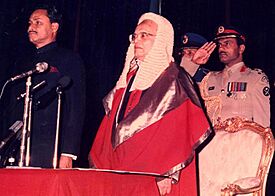
Army Chief of Staff Lieutenant General Hussain Muhammad Ershad took power in a peaceful takeover on 24 March 1982. He said the country was in a serious political and economic crisis. Ershad suspended the constitution and declared martial law.
He began to privatize many state-owned businesses and encouraged private investment. Foreign companies were also invited to invest. All political parties and trade unions were banned for a while. Many people saw Ershad's takeover as a positive step because Bangladesh was facing severe economic problems.
In 1983, Ershad became president. He tried to get opposition parties to join local elections, but they refused. In March 1985, he held a public vote on his leadership, which he won easily, though not many people voted. He then held elections for local council leaders, and pro-government candidates won most positions.
In 1986, political rights were restored, and the Jatiya Party was formed as Ershad's political group. Parliamentary elections were held in May 1986. The Jatiya Party won most seats. The Awami League, led by Sheikh Hasina (Mujib's daughter), participated, which gave the elections some credibility, even with claims of voting problems.
Ershad then resigned from the army to prepare for presidential elections in October. Both the BNP and AL refused to put forward candidates because martial law was still in effect. Ershad easily won the election. In November 1986, martial law was lifted.
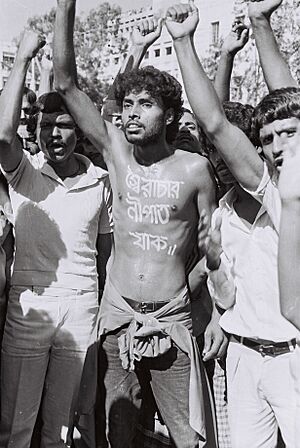
However, in July 1987, opposition parties walked out of parliament after the government passed a controversial law. This sparked a strong opposition movement that united many parties. The government arrested many activists, but protests and strikes continued. Ershad declared a state of emergency and dissolved parliament, scheduling new elections for March 1988.
All major opposition parties refused to participate in these elections, saying they would not be fair. The ruling Jatiya Party won most seats. In June 1988, parliament passed a controversial change to the constitution, making Islam Bangladesh's state religion.
By 1989, the political situation seemed calmer. However, opposition to Ershad's rule grew again by the end of 1990. There were frequent strikes, student protests, and public rallies, leading to a breakdown of law and order.
The 1990s: Return to Democracy
Transition to Democracy
Many political parties united against Ershad. Khaleda Zia, Ziaur Rahman's widow, led the Bangladesh Nationalist Party (BNP). She joined forces with the Bangladesh Awami League, led by Sheikh Hasina. Other Islamic parties also joined the opposition. They called for strikes and protests that stopped the country's activities. Students also launched strong protests, which eventually forced Ershad to step down.
On 6 December 1990, Ershad resigned. On 27 February 1991, after two months of widespread unrest, an interim government oversaw what many believed were the fairest elections in Bangladesh's history.
First Khaleda Zia Government (1991–1996)
The Bangladesh Nationalist Party (BNP) won the most seats and formed a government with support from an Islamic party. Khaleda Zia became prime minister. The people also approved changes to the constitution, bringing back a parliamentary system where the prime minister held most of the power, similar to Bangladesh's first constitution in 1972. In October 1991, parliament elected Abdur Rahman Biswas as the new head of state.
In March 1994, a disagreement over a parliamentary election led the opposition to boycott parliament. The opposition also started a series of general strikes, demanding that Khaleda Zia's government resign and a neutral caretaker government hold new elections. Efforts to solve the problem failed. In late 1994, the opposition resigned from parliament. They continued protests to force the government to resign. The opposition, including the Awami League, said they would boycott the national elections scheduled for February 1996.
In February 1996, Khaleda Zia was re-elected, but the three main opposition parties boycotted the vote, calling it unfair. In March 1996, after growing political unrest, parliament passed a constitutional change to allow a neutral caretaker government to take power and hold new elections. Former chief justice Muhammad Habibur Rahman became the chief adviser of this interim government. New parliamentary elections were held in June 1996. The Awami League won the most seats and formed the government with support from the Jatiya Party. Sheikh Hasina became the Prime Minister of Bangladesh.
First Sheikh Hasina Government (1996–2001)
Sheikh Hasina formed what she called a "Government of National Consensus" in June 1996. International and local observers said the June 1996 election was free and fair. The Bangladesh Nationalist Party (BNP) decided to join the new parliament.
However, the BNP soon claimed that police and Awami League members were arresting many opposition activists. In late 1996, the BNP walked out of parliament but returned in January 1997 after an agreement with the ruling party. The BNP later claimed this agreement was not kept and walked out again in August 1997. They returned to parliament in March 1998 under another agreement.
In June 1999, the BNP and other opposition parties again stopped attending parliament. They organized more and more nationwide strikes. An alliance of four opposition parties announced they would boycott elections unless the government took steps to ensure fairness. The government did not take these steps, and the opposition boycotted all elections, including local ones.
In July 2001, the Awami League government stepped down to allow a caretaker government to oversee parliamentary elections. Political violence increased leading up to the election. In August, Khaleda Zia and Sheikh Hasina agreed to respect the election results and join parliament, no matter who won. The caretaker government successfully controlled the violence, and a parliamentary election was held on 1 October 2001.
The 2000s: Political Shifts
Second Khaleda Zia Government (2001–2006)
An alliance led by the Bangladesh Nationalist Party (BNP) won a large majority in parliament. Khaleda Zia became prime minister for the third time on 10 October 2001.
Despite her promise and election observers calling the election fair, Sheikh Hasina criticized the results and boycotted parliament. In 2002, she led her party members back to parliament, but the Awami League walked out again in June 2003. They returned in June 2004 without their demands being met. They then attended parliament irregularly before boycotting the entire budget session in June 2005.
On 17 August 2005, bombs exploded in 63 out of 64 districts, mainly targeting government buildings. An extremist group called Jamaat-ul-Mujahideen Bangladesh (JMB) claimed responsibility. They wanted to replace the country's legal system with Islamic law. Later attacks on courts killed more people. The government launched a campaign against these extremists, arresting many JMB leaders.
In February 2006, the Awami League returned to parliament. They demanded early elections and changes to the election system, claiming the ruling party was trying to rig the next election. The Awami League accused the BNP of attacking opposition leaders. The BNP accused the Awami League of harming Bangladesh's image. Talks between the parties failed to resolve the issues.
Political Crisis and Caretaker Government (2006–2008)
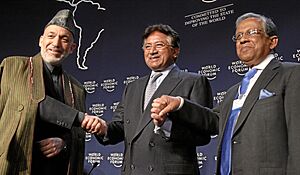
The months before the planned 22 January 2007 elections were full of political unrest. After Khaleda Zia's government ended in October 2006, there were protests and strikes because of uncertainty about who would lead the caretaker government. The caretaker government struggled to get all parties to agree. The Awami League and its allies protested, saying the caretaker government favored the BNP.
The interim period saw violence and strikes. The president, Iajuddin Ahmed, later declared a state of emergency. He then resigned as chief adviser and appointed Fakhruddin Ahmed as the new chief adviser. Political activities were banned.
The military-backed government worked to investigate corruption cases against leaders from both major parties. In March 2007, Khaleda Zia's two sons were charged with corruption. Sheikh Hasina was charged with corruption in April 2007, and Khaleda Zia was also charged a day later. There was an attempt by some army officials to remove Sheikh Hasina and Khaleda Zia from politics. The Anti-Corruption Commission and Election Commission were strengthened by the caretaker government.
In August 2007, violence broke out at the University of Dhaka between students and soldiers. Students called for strikes and burned effigies of the army chief. Police attacked students and teachers. Students were joined by street vendors and slum residents who had been removed by the government. The army agreed to the protesters' demands and removed its camp from the university.
Second Sheikh Hasina Government (2009–2014)
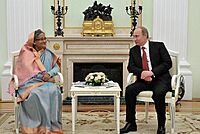
The Awami League won the national election on 29 December 2008, as part of a larger group of parties. They won 230 out of 299 seats in parliament. The Awami League and its allies received 57% of the total votes. Sheikh Hasina became the new Prime Minister on 7 January 2009. Her new cabinet included several new faces, including three women in important roles.
Since 2009, the Awami League government faced challenges like a mutiny by the border security force, power shortages, and issues in the garment industry. Important legal achievements included bringing back the 1972 constitution and starting trials for war crimes.
Vision 2021 and Digital Bangladesh
Vision 2021 was a big promise made by the Awami League before the 2008 elections. It was a plan for what Bangladesh should look like by 2021, which marked 50 years of the nation's independence.
Digital Bangladesh was part of this vision. It meant using computers and technology in smart ways to improve education, health, job opportunities, and reduce poverty. The idea was to encourage positive thinking and new ideas to make "Digital Bangladesh" a success.
The 2010s: Protests and Elections
Third Sheikh Hasina Government (2014–2019)
A general election was held on 5 January 2014. The time leading up to the election was marked by violence. The opposition BNP wanted the caretaker government system to be brought back, but it had been removed in 2011. Many parties, including the BNP, boycotted the election.
Out of 300 seats, the Awami League won 233. More than half of the seats (153) were won without anyone running against them. Voter turnout was low, around 20%. Hasina was sworn in to lead the next government.
Student Protests Against VAT on Education
In 2015, students from private universities in Bangladesh protested against a tax (VAT) placed on higher education fees. The government had first introduced a 10% VAT, then reduced it to 7.5%. After strong opposition, the VAT was removed in September 2015.
Quota Reform Movement
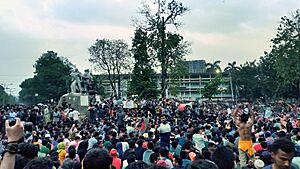
The 2018 Bangladesh Quota Reform Movement was a student movement demanding changes to the rules for getting government jobs. Students started protesting in Dhaka in February 2018, and the movement quickly spread across the country. It became very popular among students, forcing the government to announce changes to its policy.
Road Safety Protests
From 29 July to 8 August 2018, there were many public protests in Bangladesh asking for better road safety. These protests started after two high-school students in Dhaka were killed by a bus driven by an unlicensed driver. Students demanded safer roads and stricter traffic laws, and the protests spread quickly.
The protests were peaceful at first. But on 2 August, police tried to break up the protests, and people believed to be part of a pro-government youth group attacked protesters and journalists. The government arrested some protesters and a photographer. Many international groups and famous people supported the protesters. The crackdown on students received a lot of criticism.
On 6 August, the government approved a new traffic law. It included capital punishment for intentional killing and a maximum five-year prison sentence for accidental killing with a vehicle. Protesters felt that five years was too light for accidental deaths caused by reckless driving. By 8 August, the situation in the city returned to normal, and the protests ended.
Fourth Sheikh Hasina Government
The 2018 Bangladeshi general election was held on 30 December 2018. The Awami League, led by Sheikh Hasina, won a huge victory. However, the elections were marked by violence and claims of vote rigging. Opposition leader Kamal Hossain rejected the results, calling them "farcical" and demanding new elections under a neutral government.
The 2020s
COVID-19 Pandemic
The COVID-19 pandemic in Bangladesh began in March 2020. The first three known cases were reported on 8 March 2020. Since then, the virus has spread across the country, and the number of affected people has increased. Bangladesh became the second most affected country in South Asia, after India.
Mujib Year and Golden Jubilee
The government of Bangladesh announced that 2020–2021 would be celebrated as the Mujib Year to mark 100 years since the birth of the country's founding leader, Sheikh Mujibur Rahman. This celebration lasted from 17 March 2020 to 26 March 2021. The United Nations and UNESCO decided to celebrate Mujib Year jointly with Bangladesh.
For 2021, the "Bangla50" initiative was launched to celebrate 50 years of Bangladesh's independence from Pakistan. This is called সুবর্ণ জয়ন্তী (Subarṇa jaẏantī) in Bengali. Many celebration programs were held in other countries as well.
Smart Bangladesh
Smart Bangladesh is a vision for the future of Bangladesh, aiming to use technology and innovation to create a smart society, smart economy, smart government, and smart citizens.
2024 Bangladeshi General Election
In January 2024, Prime Minister Sheikh Hasina secured her fourth straight term in Bangladesh's general election. The main opposition party, the Bangladesh Nationalist Party, boycotted this election.
See also


